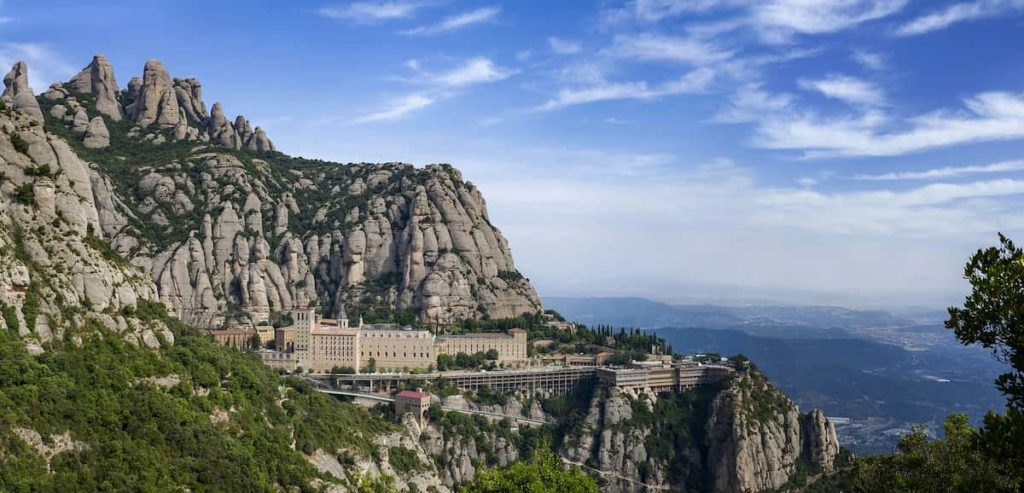The history of the Montserrat monastery has a long trajectory, even before the famous image of the Black Virgin appeared. In fact, its origins date back to prehistory, specifically from around 1199 B.C., where the first traces of ceramics decorated with elaborate designs with pechina were witnessed.
The story continues in the year 880, when the image of the Virgin of Montserrat was first found by some shepherd children in a cave located on the mountain.
This event permanently marked history, to the extent that just 8 years later, in 888, the first mention of the mountain was documented. By the year 945, a document was created to testify to the founding of the monastery of Santa Cecilia in the town of Montserrat. Until the year 1025, when the Bishop of Vic officially founded the monastery of Montserrat.

Beginnings of the Montserrat Monastery
Between the 12th and 13th centuries, the Romanesque church of Montserrat was inaugurated, and the image of the virgin, La Moreneta, was carved in wood, whose carving is still venerated today in the basilica of Montserrat.
Years later, in 1221, pilgrimage to Montserrat began to increase as the miracles of the Black Virgin were spread. In fact, its reach was so great that its fame spread throughout Europe during the 14th century, and by 1409, it had become the independent abbey of Montserrat.
In 1439, devotion to the Virgin expanded to America, and one of the Antilles Islands was named Montserrat.
Highs and Lows in Montserrat
From 1811 to 1835, Montserrat and the monastery suffered a series of losses, including its total destruction by the Napoleonic army, the loss of all its properties, and consequently, all its monks.
Until 1844, Montserrat survived with only one monk, until 1858 when construction work on the monastery began.
In 1881, the celebrations of the coronation of the Virgin of Montserrat resumed, making her the patron saint of Catalonia.
From 1936 to 1939, the Montserrat sanctuary was again attacked by soldiers during the Spanish Civil War. In this tragic event, all the monks had to leave the place, and some of them were killed. However, after the war, the government of Catalonia managed to save the monastery from destruction and looting.
Inauguration of the current monastery
Finally, between 1995 and 1997, restoration and reconstruction work was carried out on the basilica of Montserrat, as well as on the Holy Cave.
The Montserrat Basilica
The construction of the Montserrat Sanctuary, architecturally, is a mixture of Gothic and Renaissance styles that were prevalent at the time. Hence, upon entering the monastery, the first thing one notices is the upper area, where monks and a large altar can be seen.
Likewise, in the central part, one can see the image of the Virgin, on her silver throne, whose carving is the most striking feature of the entire basilica.
The difference between the Montserrat Sanctuary and other churches lies in its interconnected chapels between the buttresses, the side galleries of its upper part with arches and elaborated ribs that form lunettes with lateral oculi.
During the Napoleonic Wars from 1808 to 1814, the basilica was severely damaged until it was rebuilt in the late 19th century, retaining a “Byzantine Romanesque” decoration respected over time.
It’s worth noting that despite this Romanesque decoration, architects, sculptors, and painters who worked on the chapels and the chancel were influenced by the modernism and symbolism of the time.
Another characteristic of the Montserrat Basilica is that it is not a church of great proportions, at least not by today’s standards, but it was for those who lived during its construction, considering the location chosen for it and, above all, the means available at the time.
In the restoration carried out between 1991 and 1996, which was mentioned earlier, a brighter temple was achieved without losing the original atmosphere that invites pilgrims and visitors to find a corner of intimacy.
Finally, it is worth mentioning that under the roof of the basilica, on its central pillars, rest the sculptures of the prophets Daniel, Isaiah, Ezekiel, and Jeremiah, tasked with recalling the prophecies surrounding the Virgin Mary.
The wooden sculptures were created by the great sculptor Josep Llimona, a representative of Catalan modernism, and brought to the basilica in 1896, becoming since then one more reason to visit a monument so deeply rooted in the history of the Catalan people.
A Highlighted Tourist Attraction in Barcelona
The history, the cultural center that the monastery has been for centuries, the uniqueness of the mountainous terrain of Montserrat and its natural values, and of course, the worship of the Virgin of Montserrat have made the place one of the most prominent tourist attractions in Barcelona. Many tourists visiting Barcelona take the opportunity to take a trip or tour to Montserrat. A visit that often becomes a day trip to see the highlights of Montserrat, listen to the boys of the Escolania de Montserrat sing “El Virolai”, or pray to La Moreneta.